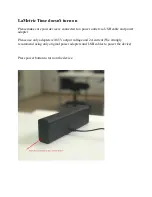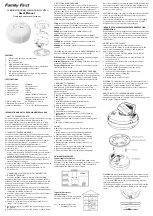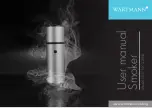
D200-39-00 3 I56-1977-004R
SCREW HOLES FOR
ATTACHING HOUSING
TO DUCT WORK.
Figure 3. Installation of foam gaskets over
sampling tube bushings:
Figure 5. Tube mounting configurations with varying
air flow direction:
Table 1. Sampling tubes recommended for different
duct widths:
Outside Duct Width Sampling Tube Recommended*
1 to 2 ft. (0.3 to 0.6 m) ST-1.5
2 to 4 ft. (0.6 to 1.2 m) ST-3
4 to 8 ft. (1.2 to 2.4 m) ST-5
8 to 12 ft. (2.4 to 3.7 m) ST-10
*Must extend a minimum of
2
⁄
3
the duct width
SAMPLING
TUBE
END CAP
AIR HOLES
ARROW
MUST FACE
INTO AIR FLOW
AIR FLOW DIRECTION
FLANGE
Figure 4. Air duct detector sampling tube:
H0108-02
AIR FLOW
DIRECTION
DETECTOR
HOUSING
DOTS INDICATE POSITION OF
SAMPLING TUBE HOLES
AIR FLOW
DIRECTION
DETECTOR
HOUSING
SAMPLING
TUBE
EXHAUST
TUBE
AIR FLOW
DIRECTION
EXHAUST
TUBE
SAMPLING
TUBE
SAMPLING
TUBE
EXHAUST
TUBE
DETECTOR
HOUSING
AIR FLOW
DIRECTION
DETECTOR
HOUSING
A.
B.
C.
D.
HORIZONTAL MOUNTING OF HOUSING
VERTICAL MOUNTING OF HOUSING
NOTE: Only metal sampling tubes can be installed in
orientations C and D.
[4.2] Installation For Ducts More Than 8 Feet (2.4m) Wide
NOTE:
To install sampling tubes in ducts more than 8 feet (2.4m) wide,
work must be performed inside the air duct. Sampling of air in
ducts wider than 8 feet (2.4m) is accomplished by using the
ST-10 sampling tube. If the tube is shorter than the width of the
air duct, install the end cap into the sampling tube as shown
in Figure 4 and support the end opposite the duct smoke detec-
tor.
Install the sampling tube as follows:
1. Drill a 3⁄4-inch (19mm) hole in the duct directly opposite the hole
already drilled for the sampling tube. Make sure the hole is 1
″
to 2
″
(25 to 50mm) below the inlet hole on the opposite side of the duct to
allow for moisture drainage.
2. Slide the sampling tube with the flange into the housing bushing that
meets the air flow first. Position the tube so that the arrow points into
the air flow. Secure the tube flange to the housing bushing with two
#6 self-tapping screws.
3. From inside the duct, couple the other sections of the sampling tube
to the section already installed using the
1
⁄
2
-inch conduit fittings sup-
plied. Make sure that the holes on both of the sampling tubes are lined
up and facing into the air flow.
4. Trim the end of the tube protruding through the duct so that 1
″
to 2
″
(25 to 50mm) of the tube extend outside the duct. Plug this end with
the end cap and tape closed any holes in the protruding section of the
tube. Be sure to seal the duct where the tube protrudes.
NOTE:
An alternate method to using the ST-10 is to use two ST-5 sam-
pling tubes. Remove the flange from one of the tubes and install
as described above. After the installation, use electrical tape to
close off some of the sampling holes so that there are a total of
10 to 12 holes spaced as evenly as possible across the width of
the duct.
2. Slide the tube into the housing bushing that meets the air flow first.
Position the tube so that the arrow points into the air flow, as shown
in Figure 4.
3. Secure the tube flange to the housing bushing with two #6 self-tapping
screws.
4. For tubes longer than the width of the air duct, the tube should extend
out of the opposite side of the duct. If there are more than 2 holes in
the section of the tube extending out of the duct, select a different
length using Table 1. Otherwise, trim the end of the tube protruding
through the duct so that 1
″
to 2
″
(25 to 50mm) of the tube extend
outside the duct. Plug this end with the end cap and tape closed any
holes in the protruding section of the tube. Be sure to seal the duct
where the tube protrudes.
NOTE:
The sampling tube end cap is critical to the proper operation of the
duct smoke detectors. The end cap is needed to create the proper air flow
to the sensor of the duct smoke detector.


























